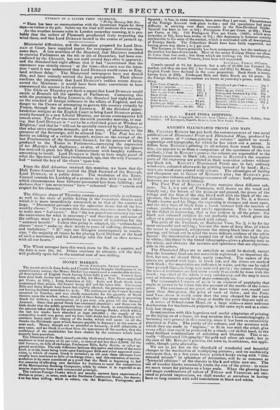KNIGHT'S ILLUMINATED PRINTS AND MAPS.
MR. CHARLES KNIGHT has put forth the commencement of two serial publicatiens of Illuminated Prints and Illuminated Maps, produced by a new process of " surface-printing in colours " applied to wood- engravings and typography, for which he has taken out a patent. It differs from BAXTER'S printing ia oil.colours from wood blocks, in this, (as appears to us from a comparison of the specimens of the two methods,) that in KNIGHT'S process the colours are superadded to the ordinary impression in black ink, whereas in BAXTER'S the separate parts of the engraving are printed in their respective colours without any black ink. KNIGHT'S Illuminated Prints are, in fact, ordinary wood.ctits, coloured afterwards by printing instead of by hand ; Bax- TER'S are wood.cuts printed with colours. The advantages of facility and cheapness are in favour of KNIGHT'S plan ; but BAXTER'S pro- duces greater richness and homogeneousness of colour : both processes, however, are yet in their infancy. The First Part of KNIGHT'S Prints contains three different sub- jects. No. 1, is a pair of Ptarmigan, well drawn on the wood and sharply cut ; the brown of the plumage and ground, the green of the foliage and the blue of the sky, blend well with the black of the im- pression, the lines being close and delicate. But in No. 3, a Sussex Truffle. hunter and his Dogs, the engraving is stronger and more open, and the wiry lines of black form a harsh contrast with the touches of colour, producing a crude and patchy appearance. This is increased by the defect in registering, that is too evident in all the prints : the black and coloured outlimts do not perfectly unite, which gives the effect of a prim carelessly washed with colour.
The print of the Portland, or Barherini Vase, No. 2, is by far the most successful and striking; because the mass of deep blue, of which the vessel is composed, overpowers the strong black lines of the en- graving, and Firings out in relief the more delicate outlines of the white figures : the introduction of a neutral tint of buff, with the high lights in white—like those in the tinted lithography—gives a pleasing tone to the whole, and obviates the rawness and spottiness that are objection- able in the others.
The Illuminated Maps are as complete as could be desired, except that the boundary lines are not accurately registered ; an important de- fect, but one, we should think, easily remedied. The names of the places are printed with type, in black ink, Red the rivers are marked with black ; the mountains are indicated in white, and the sea by ruled lines printed blue—loaking very neat and pretty ; the colours denoting the several territories are laid more evenly than could be done with the brush : the effect of the whole is very satisfactory, and the map is more easy of reference than engraved maps commonly hire.
The unexampled lowness of price is an element of popularity that ought in justice to be taken into the account of the merits of the enter- prise. The commonest toy.print, of the most vulgar sort, would cost more than threepence, time price of each of these ; and the Port- land Vase alone is worth more than the sum charged for the whole number : the maps would be cheap at double the price they are sold at.
A series of School-room Maps, on a large scale—a most welcome desideratum for teachers—is preparing, in the same style and at a simi- larly low charge.
In conjunction with this ingenious and useful adaptation of printing to the laying.on of colours, we may mention that Chromalithography is becomiug very general in this country, since it has been so extensively practised in Paris. The purity of the colours, and the accuracy with which they are made to "register," or fit in one with the other, give every effect that could be produced by a steady and skilful band, to the most brilliant combinations of colouring and blazonry. This is ac- welly "illuminated lithography," for gold and silver are used ; but in the case of Mr. KNIGHT'S plocess, the term is, in strictness, not appli- cable, though quite allowable. We are as yet but on the threshold of wonderful and beautiful changes in the mechanism of multiplying pictures ; and we confidently anticipate that, in a few years hence printed books tieing with "illu- minated missals" in splendour of decoration, will be as common as ";pictorial editions" of the classics in black and white now are. The use of wooden blocks necessarily limits the size of the prints : to stone we must resort for pictures on a large scale. When the glowing hues and magic combinations of colour of TITIAN and VERONESE are imi- tated in printed impressions, we shall wonder at ourselves in having been so long content with cold translations in black and white.


























 Previous page
Previous page